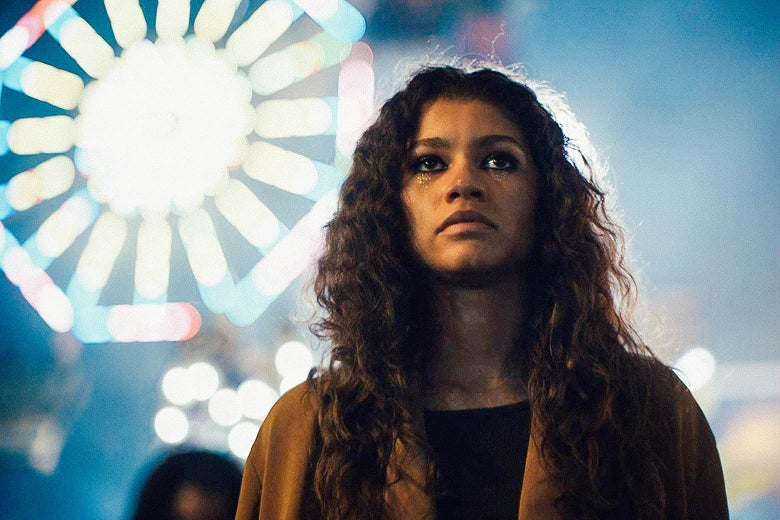Photo courtesy of Slate.
KIRAN BRAR | STAFF REPORTER | kbrar@butler.edu
This past summer, HBO aired the drama series “Euphoria,” starring Zendaya. In an incredibly raw manner, the show highlights various problems the Generation Z demographic encounters. With recent movements encompassing the importance of LGBTQ+ inclusivity, body positivity and destigmatizing mental health, this show provides an entertaining yet educational platform for the Gen Z demographic to have a voice.
Unlike most contemporary teenage dramas that often glorify or sugarcoat sensitive topics, “Euphoria” covers explicit themes while giving the show an unfiltered approachability for audiences to enjoy and relate to.
The show circles the lives of a group of teenagers living in the same town, all going through their own problems. Zendaya portrays Rue, a teenager just out of rehab with no intentions of staying clean.
The show jumps straight into Rue’s life by immediately showcasing her drug addiction and multiple mental health issues including depression, anxiety, OCD and ADD.
Mental health continues to be a topic of high concern in our society, especially now that it’s National Suicide Prevention Month. Zendaya’s portrayal of Rue allows mental illness to not be a taboo point of conversation, but an acknowledged aspect of many people’s lives.
Although Rue narrates the show, an abundance of vivid supporting characters allows for more perspectives to be shown on a societal and cultural level. These different perspectives give viewers the opportunity to relate and empathize with characters in the show and everyday people.
Other characters include Jules, whose journey and character development is focused around self-harm and gender identity. Rue and Jules are codependent on each other throughout the series, and portray unhealthy coping methods as they face their hardships together.
Kat adds yet another perspective regarding identity in the show. Her character arc evolves from being self-conscious about her weight to becoming sexually liberated and confident.
Chris McKay portrays college life, and the pressures and difficulties that accompany it. His girlfriend Cassie adds the perspective of being sexualized from an early age and, as a result, feels pressure to partake in sexual activities.
Maddy’s character shows the conflict between understanding love and breaking away from a toxic relationship, because her boyfriend Nate is rage-filled, abusive and controlling throughout the show.
Levi Elliot, a senior gender, women and sexuality studies and critical communications and media double major, was drawn to the realistic depictions of young people in the 21st century.
“They were actually complex people,” Elliot said. “They remind me of my friends.”
Along with the plot, “Euphoria” excels in overall style and atmosphere. The cinematography masterfully uses color and light to convey different moods and frame different scenes. Another important aspect other than the visual aesthetics of the show was the music that accompanied it.
The soundtrack enforces the mood and tone and evokes powerful feelings throughout the show. The juxtaposing energies of a party, an intimate scene or anything in between is heightened due to the show’s song selections.
Elliot also spoke on how the visual components of the show compliment prominent themes.
“My favorite thing stylistically would have to be the cinematography and the narrative,” Elliot said. “It was narrated by Rue, by someone that was going through something as well, and a lot of the scenes were shot in a way that reflected what the person’s mindset was like.”
Scenes that weaved themselves throughout the plot also aesthetically made full use of contemporary fashion.
“The makeup and clothing style has started its own trend,” Elliot said.
These trends can be observed at New York Fashion Week, with “W Magazine” dubbing runway makeup looks, the “Euphoria effect”. Tilden Bissel writes about the show’s impact on one of the year’s biggest showcases of fashion.
“One thing is clear: eye-catching makeup was big this week,” Bissel reports. “Call it the Euphoria effect: from the runways to the after-parties, glitter was everywhere. Jeremy Scott had models made up in pastel punk hair with makeup by Kabuki, while Gigi Hadid showed her support in a razor-sharp smokey eye.”
The different topics presented in the show might be considered excessive, dramatic and explicit, but it is our reality. At times the show may have confused audiences because of the abundance of themes and characters — that’s the point. “Euphoria” is creating a gateway for continuing conversations amongst all demographics.
With these topics and problems coming to light, it is important to talk about the complexities that “Euphoria” covers to progressively move forward in our society. Now that the vast majority of Butler students are members of Generation Z, there’s a cultural obligation to acknowledge and instigate conversation on campus about topics that directly impact us.
So, let’s talk about it.




Pingback: euphoria demographic – databaseor